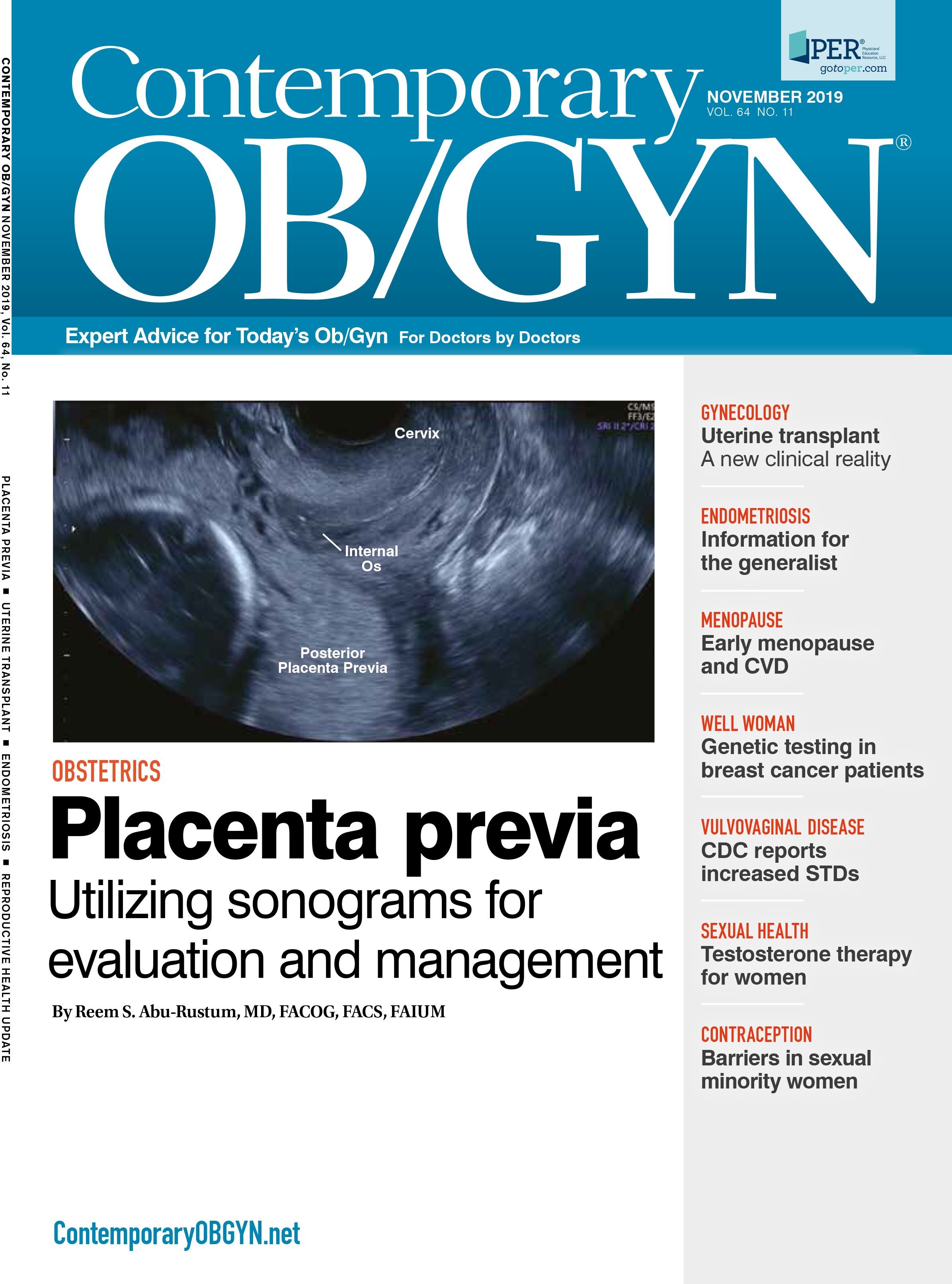When is it time for the ob/gyn to assume care?
Inability to recognize that a patient requires care from a specialist may lead to allegations of negligence.
©Feng Yu - shutterstock.com

Facts
A 32-year-old G1P0 who lived in a small, remote community presented to her family physician for her first obstetrical appointment at 11w5d. She was noted to have chronic hypertension, with a weight of 254 lb, and a body mass index of 46.45 kg/m2. Her untreated blood pressure (BP) was 130/85 mmHg. She underwent an ultrasound at 17w6d that revealed a single vertex at 17w5d, with an estimated fetal weight (EFW) of 2112 g (41st percentile), with no fetal anomalies visualized. A 1-hour glucose tolerance test (GTT) at 24w5d showed a glucose level of 191 mg/dL and a 3-hour GTT at 25w3d was abnormal, with the following results:
- Fasting blood glucose (BG) - 101 mg/dL,
- 1-hour BG - 213 mg/dL,
- 2-hour BG -169 mg/dL, and
- 3-hour BG - 141 mg/dL.
The family physician referred the patient to an obstetrician, who performed a second ultrasound which was consistent with 24w3d, and consistent with the patient dates placing her at 25w5d. The obstetrician recommended placing the patient on insulin and referred her back to the family physician for ongoing care. The family physician observed the patient and did not institute insulin over the next 7 weeks. The patient’s blood sugars obtained at various times of the day were reported to be between 110 mg/dL and 240 mg/dL. An ultrasound obtained at 32w4d was consistent with 30w6d. No estimated fetal weight was reported. The patient was referred back to the obstetrician at 33w2d, who again recommended insulin. Further recommendations included fetal testing with weekly non-stress tests (NST) and ultrasounds every 2 weeks. The obstetrician again referred the patient back to the family physician, with a recommendation to institute insulin and induce the patient at 37 to 38 weeks of gestation. Of note, the patient’s blood pressure remained relatively stable without treatment.
The family physician instituted lose-dose insulin, at 10 units of regular insulin in the morning. The patient’s BG remained between 75 mg/dL (fasting) and 120 mg/dL (post-prandial). The patient had reactive NSTs on a weekly basis. An ultrasound at 34w3d was consistent with 34w0d, with an EFW of 2434 g (32nd percentile), an amniotic fluid index (AFI) of 9.19, and an anterior placenta.
At 8:40 AM at 36w3d, the patient presented to labor and delivery with complaints of cramping, back and abdominal pain, and a small amount of vaginal bleeding. She had a reactive NST with a baseline fetal heart rate (FHR) of 130 to 140 beats per minute (bpm). The obstetrician was consulted, performed a limited ultrasound, and concluded that there was no obvious placental abruption. Approximately 30 minutes after that ultrasound, the FHR revealed an oscillatory pattern between 160 and 180 bpm, with absent variability. The FHR then dropped to the 80s and 90s for approximately 7 minutes. The patient was turned to her right and then left side, oxygen was placed, and the FHR gradually returned to the 150s. The patient continued complaining of cramping and back and abdominal pain. The FHR increased to the 170s with minimal variability and no significant decelerations (Category II). The obstetrician recommended a biophysical profile (BPP), which was done and scored at 4 out of 8. “Sluggish movement of the heart” was noted on ultrasound as was an unusual appearance of the fetal small bowel. Radiology recommended a detailed fetal ultrasound if the patient remained pregnant. While in radiology from 10:48 to 11:08 AM, the patient was unmonitored. Upon arriving back on labor and delivery, the FHR was 170 bpm with minimal variability.
Facts (cont'd)
The patient was admitted for induction of labor, with a documented indication of an abnormal BPP and suspected placental abruption. On exam, her cervix was 2 cm, with a floating presentation. The obstetrician recommended misoprostol followed by oxytocin. The patient was returned to her family physician for management of induction, which was started at 12:15 PM. At that time the FHR was 160 to 170 bpm, with decreased variability. At 12:45 PM, the FHR revealed an oscillatory pattern between 100 and 140 bpm, with absent variability. The nurses had the patient sign an informed consent for cesarean delivery at 1:00 PM. Shortly thereafter, the FHR returned to a baseline of 160 bpm with minimal to absent variability. This pattern persisted over the course of the next 5 hours, with three spontaneous decelerations to the 70s for 60 to 80 seconds. At 5:50 PM there was an episode of fetal bradycardia to 70 bpm which lasted almost 3 minutes. Although the FHR returned to 130 bpm, there were recurrent late decelerations of 20 bpm, with absent variability. At 6:25 PM, the family physician consulted with the obstetrician, who agreed to proceed with cesarean delivery for non-reassuring fetal status.
The patient was delivered at 7:15 PM, 50 minutes after the decision for cesarean. Apgar scores were 1 and 2 at 1 and 5 minutes, respectively. The family physician provided initial newborn resuscitation as pediatrics had not been called. Deep suctioning revealed bright-red bloody mucous. No umbilical cord gases were obtained. The placenta was not sent to pathology. The operative note did not document presence of an abruption or whether blood was present in the amniotic fluid. Pediatrics arrived approximately 30 minutes after delivery. The baby was hypotensive, in shock, and had severe anemia and a glucose of 37%. Intravenous access was thus difficult. The baby was placed in a hood with 75% oxygen.
Arterial blood gases returned as follows:
- pH - 7.24
- pCO2 - 48 mmHg
- pO2 - 103 mmHg
- O2 saturation - 100%
The admitting diagnosis in the nursery was severe anemia; hypotension, with severe renal and intestinal compromise; hypoglycemia; probable respiratory distress syndrome; and possible sepsis. The patient was transferred to a university hospital, where the baby was hospitalized for 2 months. The baby had complete renal failure and no renal function, attributed to anoxia at birth, requiring peritoneal dialysis. Diffuse anoxic injury with cerebral infarcts and recurrent seizures also was present. The baby had respiratory distress syndrome, in addition to anemia, thrombocytopenia, hypogammaglobulinemia, thrombocytosis, chyloperitoneum, and peritonitis due to α-hemolytic strep. The baby receives home dialysis for 10 hours per day and is on a transplant list. The baby requires tube feedings and receives growth hormone due to poor growth.
Depositions of the involved physicians revealed only two progress notes before induction of labor and one with the decision for cesarean delivery, all written by the obstetrician. There were no notes during induction of labor. Further, the obstetrician admitted that he had not assessed the family physician’s experience in caring for a pregnant patient who required insulin. In addition, he had no explanation for why he did not assume care of the patient in the labor and delivery unit.
Allegations
The plaintiff’s expert testified that the obstetrician should have assumed antepartum care of the patient when insulin was required for blood glucose control. However, despite this breach, the patient’s blood glucose was well-controlled, and the fetus grew appropriately, with no evidence of macrosomia. Further, a detailed ultrasound was indicated with morbid obesity and insulin-requiring diabetes. The expert also testified that induction of labor was contraindicated, due to the non-reassuring fetal assessment and poor Bishop score, with an anticipated extensive time from induction to delivery. Pursuing induction in the presence of significantly abnormal FHR tracings, such as an oscillatory pattern, was a breach of the standard of care. Had the patient been delivered expeditiously after obtaining the abnormal BPP or after the abnormal pattern shortly after induction, the baby would likely have recovered. Further, the obstetrician was negligent in not assuming care of the patient on labor and delivery. Absence of a physician knowledgeable in FHR assessment led to the delay in intervening with a cesarean delivery, directly resulting in the adverse fetal outcome. Compounding the situation was that pediatrics was not called to be at the delivery of the baby.
Verdict
The jury verdict found for the plaintiff, with a verdict of $3.4 million against the physicians, apportioned 80% against the obstetrician and 20% against the family physician.
AnalysisThis case presents a unique situation, as areas in the country with limited obstetrical coverage often rely on family physicians to provide obstetrical care. Care can be coordinated between the family physician and the obstetrician. However, it is important to recognize when the care of a patient should either be assumed by the obstetrician, or frequent communication and consultation should occur between the family physician and the specialist obstetrician. This family physician appropriately referred the patient to the obstetrician when the abnormal GTT was obtained. The patient was referred back to the family physician without assessing his experience or comfort level in caring for such a patient. Depositions revealed that the family physician had not personally cared for an insulin-dependent pregnant patient previously. Despite this, the patient’s blood glucose levels were relatively well controlled on low-dose insulin, with reassuring fetal antepartum testing. Her blood pressure was fairly well-controlled without therapy.
The patient presented to labor and delivery with symptoms consistent with a placental abruption. Assessment on labor and delivery was not reassuring. The abnormal BPP dictated delivery. However, the patient was a relatively poor candidate for induction of labor, with a non-reassuring FHR tracing, and a long cervix, 2 cm dilated, with a floating presentation (Bishop score = 1). The obstetrician was found to be negligent in not assuming care of the patient at that time. The situation was compounded as the family physician did not document any assessment of the patient for more than 6 hours during the attempted induction of labor. As such, no defense could be constructed for delayed recognition of the abnormal FHR tracings or the delay in proceeding with a cesarean delivery. Although the obstetrician responded to the request for a cesarean delivery in a relatively prompt manner, the lack of his personally managing the patient on labor and delivery could not be justified.

